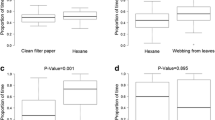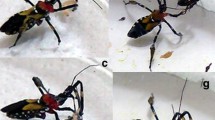Abstract
In an oak forest (Quercus frainetto) flight barrier traps baited with ethanol were used in order to attract wood and bark boring insects and study their flight pattern. There were trapped 19 species from which 9 were Scolytidae, 3 Bostrychidae, 2 Anobiidae, 1 Platypodidae and 1 Buprestidae. The most frequently species trapped was Xyleborus saxeseni. Totally 5 scolytid species (X. saxeseni, X. dispar, X. monographus, X. dryographus and Trypodendron signatum) were trapped in relatively high numbers. Their flight pattern is presented and discussed.
Zusammenfassung
In einem Eichenwald (Quercus frainetto) Griechenlands wurden Schlitzfallen angewandt, um holz- und rindenbrütende Käfer anzulocken sowie ihre Flugperiode festzustellen. Es wurden 19 Insekten-Spezies angelockt: 9 Scolytidae, 3 Bostrychidae, 3 Cerambycidae, 2 Anobiidae, 1 Platypodidae and 1 Buprestidae. Die am häufigsten gefangene Art warXyleborus saxeseni. Insgesamt 5 Scolytidae-Spezies (X. saxeseni, X. dispar, X. monographus, X. dryographus undTrypodendron signatum) wurden in relativ hohen Zahlen gefangen. Ihre Flugperioden werden mitgeteilt und diskutiert.
Similar content being viewed by others
References
Cade, S. C.;Hrutfiord, B. F.;Gara, R.I., 1970: Identification of a primary attractant forGnathotrichus sulcatus isolated from western hemlock logs. J. econ. Ent.63, 1014–1015.
Grüne, S., 1979: Handbuch zur Bestimmung der europäischen Borkenkäfer. Verlag M. & H. Schaper, Hannover.
Kailidis, D. S., 1981: The insects of oaks in Greece. Aristotelian University of Thessaloniki. Scient. Ann. School of Agric. and For, Sec. of Forestry24, 129–139.
Kailidis, D. S.;Georgevits, R., 1974: The forest insects of Greece. Aristotelian University of Thessaloniki, Scient. Ann. of Agric. and For. School16, 233–271.
Kerck, K., 1972: Äthylalkohol und Stammkontur als Komponenten der Primärlockung beiXyloterus domesticus L. (Col: Scolytidae). Naturwiss.59, 423.
Kerck, K., 1978: Einfluß baum- und käferbürtiger Reize auf das Suchverhalten vonXyloterus domesticus L. Naturwiss.65, 542.
Klimetzek, D.;Köhler, J.;Vité, J. P.;Kohnle, U., 1986: Dosage response to ethanol mediates host selection by “secondary” bark beetles. Naturwiss.73, 270.
Klimetzek, D.;Vité, J. P.;Mori, K., 1980: Zur Wirkung und Formulierung des Populationslockstoffes des NutzholzborkenkäfersTrypodendron (=Xyloterus) lineatum. Z. ang. Ent.89, 57–63.
Moeck, H. A., 1970: Ethanol as the primary attractant for the ambrosia beetleTrypodendron lineatum (Coleoptera: Scolytidae). Can. Ent.102, 985–995.
Moeck, H. A., 1971: Field tests of ethanol as a scolytid atractant. Can. Dep. For. Bi-mon. Res. Notes27, 11–12.
Mühle, H., 1980: Ergebnisse der Albanien-Expedition 1961 des Deutschen Entom. Inst. Beitr. Ent.30 (2), 369–383.
Oertzen, E. U., 1886: Verzeichnis der Coleopteren Griechenlands und Kretas Berl. Ent. Zeitschr.30 (2), 189–293.
Roling, M. P., Kearby, W. H., 1975: Seasonal flight and vertical distribution of Scolytidae attracted to ethanol in an oak-hickory forest in Missouri. Can. Ent.107, 1315–1320.
Schedl, K. E., 1967: Die Borkenkäfer von Griechenland und Cypern. Notulae Entom.47, 65–76.
Schimitschek, E., 1944: Forstinsekten der Türkei und ihre Umwelt. Volk und Reich Verlag, Prag.
Schroeder, L. M., 1988: Attraction of the bark beelteTomicus piniperda and some other bark- and wood-living beetles to the host volatiles a-pinine and ethanol. Entom. exp. appl.46, 203–210.
Schwenke, W., 1974: Die Forstschädlinge Europas. 2. Band, Käfer. Verlag Paul Parey, Hamburg und Berlin.
Schwerdtfeger, F., 1981: Die Waldkrankheiten. 4. Aufl. Verlag Paul Parey, Hamburg und Berlin.
Vité, J. P., 1979: Synergism between chemical and physical stimuli in host colonization by an ambrosia beetle. Naturwiss.66, 528.
Vité, J. P.;Franke, W., 1985: Waldschutz gegen Borkenkäfer: Vom Fangbaum zur Falle. Chemie in unserer Zeit19 (1), 11–21.
Author information
Authors and Affiliations
Rights and permissions
About this article
Cite this article
Markalas, S., Kalapanida, M. Flight pattern of some Scolytidae attracted to flight barrier traps baited with ethanol in an oak forest in Greece. Anz. Schadlingskde., Pflanzenschutz, Umweltschutz 70, 55–57 (1997). https://doi.org/10.1007/BF01996922
Issue Date:
DOI: https://doi.org/10.1007/BF01996922




